#andean cinema
Explore tagged Tumblr posts
Text
[ad_1] Who would have thought that the moon one day would be added to the list of endangered heritage sites by the World Monuments Fund (WMF)? WMF is an organisation dedicated to protecting cultural heritage sites around the globe. Every year, it compiles a list of heritage sites it deems at risk and aims to build awareness about it. Now, you would assume all these heritage sites are on earth. But surprisingly, this year, it has included one particular site that’s out-of-the-wolrd. Literally! They have recently included the moon in their annual list of endangered sites. But Why Moon? Bénédicte de Montlaur, president and CEO of WMF, told The Art Newspaper that the moon was included because of “mounting risks amidst accelerating lunar activities” that lack proper preservation measures. She stressed the need to protect artefacts representing humanity’s first ventures beyond Earth, describing this as a “defining moment in our shared history.” “For the first time, the Moon is included on the Watch to reflect the urgent need to recognize and preserve the artefacts that testify to humanity’s first steps beyond Earth—a defining moment in our shared history,” said WMF president and CEO Bénédicte de Montlaur in a statement. “The inclusion of the Moon underscores the universal need for proactive and cooperative strategies to protect heritage—whether on Earth or beyond—that reflect and safeguard our collective narrative,” de Montlaur added. What All Is Included In The List? WMF’s 2025 features 25 sites on Earth and space. Barotse Floodplain Cultural Landscape, Zambia Belfast Assembly Rooms, Northern Ireland, UK Bhuj Historic Water Systems, India Buddhist Grottoes of Maijishan and Yungang, China Chapel of the Sorbonne, France Chief Ogiamien’s House, Nigeria Cinema Studio Namibe, Angola Erdene Zuu Buddhist Monastery, Mongolia Gaza Historic Urban Fabric, Palestine Historic City of Antakya, Turkey Historic Lighthouses of Maine, US Jewish Heritage of Debdou, Morocco Kyiv Teacher’s House, Ukraine Monasteries of the Drino Valley, Albania Musi River Historic Buildings, India Hokuriku Region, Japan Noto Peninsula Heritage Sites, Japan Qhapaq Ñan, Andean Road System in South America Ruins of Old Belchite, Spain Serifos Historic Mining Landscape, Greece Swahili Coast Heritage Sites (Comoros, Kenya, Mozambique, Tanzania) Terracotta Sculptures of Alcobaça Monastery, Portugal The Great Trading Path, US The Moon Waru Waru Agricultural Fields, Peru Water Reservoirs of Tunis Medina, Tunisia [ad_2] Source link
0 notes
Text
[ad_1] Who would have thought that the moon one day would be added to the list of endangered heritage sites by the World Monuments Fund (WMF)? WMF is an organisation dedicated to protecting cultural heritage sites around the globe. Every year, it compiles a list of heritage sites it deems at risk and aims to build awareness about it. Now, you would assume all these heritage sites are on earth. But surprisingly, this year, it has included one particular site that’s out-of-the-wolrd. Literally! They have recently included the moon in their annual list of endangered sites. But Why Moon? Bénédicte de Montlaur, president and CEO of WMF, told The Art Newspaper that the moon was included because of “mounting risks amidst accelerating lunar activities” that lack proper preservation measures. She stressed the need to protect artefacts representing humanity’s first ventures beyond Earth, describing this as a “defining moment in our shared history.” “For the first time, the Moon is included on the Watch to reflect the urgent need to recognize and preserve the artefacts that testify to humanity’s first steps beyond Earth—a defining moment in our shared history,” said WMF president and CEO Bénédicte de Montlaur in a statement. “The inclusion of the Moon underscores the universal need for proactive and cooperative strategies to protect heritage—whether on Earth or beyond—that reflect and safeguard our collective narrative,” de Montlaur added. What All Is Included In The List? WMF’s 2025 features 25 sites on Earth and space. Barotse Floodplain Cultural Landscape, Zambia Belfast Assembly Rooms, Northern Ireland, UK Bhuj Historic Water Systems, India Buddhist Grottoes of Maijishan and Yungang, China Chapel of the Sorbonne, France Chief Ogiamien’s House, Nigeria Cinema Studio Namibe, Angola Erdene Zuu Buddhist Monastery, Mongolia Gaza Historic Urban Fabric, Palestine Historic City of Antakya, Turkey Historic Lighthouses of Maine, US Jewish Heritage of Debdou, Morocco Kyiv Teacher’s House, Ukraine Monasteries of the Drino Valley, Albania Musi River Historic Buildings, India Hokuriku Region, Japan Noto Peninsula Heritage Sites, Japan Qhapaq Ñan, Andean Road System in South America Ruins of Old Belchite, Spain Serifos Historic Mining Landscape, Greece Swahili Coast Heritage Sites (Comoros, Kenya, Mozambique, Tanzania) Terracotta Sculptures of Alcobaça Monastery, Portugal The Great Trading Path, US The Moon Waru Waru Agricultural Fields, Peru Water Reservoirs of Tunis Medina, Tunisia [ad_2] Source link
0 notes
Text
Art Studio 1 Excursion: ArtSpace, AGNSW and MCA - PART 2 (10.5.24)
MCA: 24th Sydney Biennale
Juan Davila's oil paintings
Row 1: Untitled (2021), Untitled (2023)
Row 2: Untitled (2021), After Image Wilderness (2010)




Description: "Asked why he chose painting, Juan Davila once answered, 'An enjoyment … does not need explanation. Over an artistic career spent lacerating political figures, government policy and state control, the artist has indeed consistently refused to explain himself. From the outset, Davila's paintings have unflinchingly interrogated cultural, sexual and social identities, taking cues from popular culture, political discourse and mythology to create a complex and provocative body of work. Born in Chile, Davila moved to Naarm/Melbourne in 1974 after the fall of the socialist Allende government. However, his work does not suggest what 'should be', instead richly-illustrating the joys, anxieties, shames and triumphs of the contemporary moment. Psychological and psychoanalytic themes are often present, but the artist refuses to articulate or reveal a clear position, prompting us to question our own biases."
Freddy Mamani
Left to right: Diablada (2024, wood coated in gloss enamel), Salon Gallo de Oro (2024, maquette)


Description: "For the past 15 years, Aymaran architect Freddy Mamani has been designing and building Cholets, a combination of the French word 'chalet' and 'cholo', a reappropriated term once used to disparage those of indigenous descent in Bolivia. Interrupting the monotony of the existing cityscape with his vibrant and distinct neo-Andean style, each Cholet recalls the colours, designs and patterning unique to the Aymara culture. The title Diablada, in particular, recalls the Danza de los Diablos, an Andean cultural dance characterised by performers wearing carnivalesque costumes of trickster devil characters. Neo-Andean architecture largely emerged during the presidency, from 2006 to 2019, of Evo Morales, who was Bolivia's first indigenous leader in the country's 200-year history. It can be seen as a consequence of both his economic policies, which empowered a generation of Aymara business people, and of the sense of pride he instilled in the country's indigenous majority. Designed specifically for the needs of the Aymaran people, each Cholet is three to seven storeys high and follows the same essential layout; the ground floor is dedicated to commercial activities, the middle floors to cultural events, while the upper floors are residences. In this way, each Cholet develops and sustains its own economy. As Mamani says, 'this architecture has its own language, its own culture, its own identity'."
Left to right: Sergey Parajanov's The Colour of Pomegranates, (Out-takes and camera tests) (1969, film installation - colour film), Frank Moore's Lullaby (1997, oil on canvas with red pine frame)


Description of Parajanov's The Colour of Pomegranates: "The Colour of Pomegranates follows the 18th-century ashug (poet, singer) Sayat-Nova from his time in Georgia's royal court, love affair with a princess, consequent expulsion and journey across the Caucasus, to his death in a monastery. Transcending both traditional narrative and national boundaries to draw inspiration from across the region, much like Sayat-Nova's songs, the film recalls a series of Persian or Armenian illuminated miniatures. Created in the years following filmmaker Sergey Parajanov's disavowal of social realism and before his 1973 arrest by Soviet authorities under false charges, it contains references to the endurance of cultures across the South Caucasus region (Armenia, Azerbaijan, Georgia, as well as Ukraine) in the face of Soviet oppression. Re-edited by Sergei Yutkevich, a key figure of the avant-garde during the 1920s, his version balanced Parajanov's poetic style with the Gosfilmofond's (Russia's state film archive) demands to make the film more accessible. Thanks to documentary filmmaker Daniel Bird and the National Cinema Center of Armenia, the unseen out-takes from The Colour of Pomegranates were presented at the International Film Festival Rotterdam in 2019. Over a hundred canisters of out-takes have survived despite the Soviet authorities blocking its distribution. Such film would typically have been recycled rather than preserved. Starring Sofiko Chiaureli, who plays six characters, The Colour of Pomegranates left a lasting impact on the film industry and survives as a testament to the power of poetry as a form of resistance across centuries."
Description of Moore's Lullaby: "Ernest Hemingway once suggested that each person dies twice, once when they pass away and again when the last person to remember them forgets. However, if someone is forgotten before they die, then it might feel as if they never existed. This was the reality for those who lived through the AIDS crisis. For years, as people became sick and died America's gay community was ignored by the media and government. Painter and activist Frank Moore, who at 48 died with HIV/AIDS, created Lullaby by transforming his own sick bed into a whimsical landscape populated by a herd of buffalo. Given US President Ronald Reagan did not so much as utter the word AIDS until four years into the crisis, Moore suspected that his community, much like the endangered buffalo, was being left to become extinct. Drawing parallels between the AIDS epidemic and burgeoning ecological crises, Moore believed that this was an apocalypse for himself and those he loved."
Serwah Attafuah's Between this World & the Next (2023-2024, film installation - digital animation (3D computer-rendered models), and e-waste on wooden frame)






Description: "Serwah Attafuah's digital creation unfolds in a near-future Ghana, drawing viewers into an Afrofuturistic vista contrasting colonial remnants with utopian hope. The narrative, propelled by burning slave castles, sinking colonial ships and formidable female warriors, weaves a tale that is both haunting and empowering. This work embodies Ghana's matrilineal legacy, while addressing contemporary issues like e-waste dumping, symbolised by a bespoke frame crafted from e-waste and the incorporation of Sakawa, or 'internet magic. Responding to William Strutt's Black Thursday, February 6th, 1851, also on display, Attafuah delves into West African history, land rights and climate impact on its indigenous communities, fostering a dialogue between historical reverence and visionary insight. Through imaginative storytelling, Attafuah challeges conventional viewpoints and incites reflection, offering commentary on transcending historical bounds. Her avant-garde blend of cultural reflections with futuristic aesthetics establishes this work as a conversation between past legacies and speculative horizons, towards a reimagined future."
BONUS: Maria Fernanda Cardoso's Butterfly Drawings - Morpho didius (Peru) (2004, archival butterfly wings, acrylic, silicone and metal)





Description: "First, I wanted to be a scientist but I used more the model of theRenaissance artist, like Leonardo, which was scientist and artist. So lwent into art thinking that I could do both, I could do art and science." - Maria Fernanda Cardoso
"Maria Fernanda Cardoso is renowned for her use of unconventional materials, which often include symbolically charged elements from the natural world. ...a selection of the artist's butterfly drawings, featuring the insect's delicate wings arranged in mandala-like patterns. Underpinning these works is a system of geometry and repetition. The drawings invite us to look more closely and reflect on our complex relationship to the natural world."
0 notes
Text
Bogotá is Colombia’s sprawling, high-altitude capital
Streets of Bogota on Rainy days

Bogota is located in the Colombian Andean Region at 8,660 feet of altitude. Its weather is chilly and very rainy. Although it’s a beautiful city to explore and very friendly to walk around, it’s good to have a back-up plan for when it rains and you find yourself with nothing to do.
The best things to do in Bogota when it rains:
Seek shelter in a museum


The historic centre of Bogota, La Candelaria, is by far the nicest part of the city to visit. The central square, Plaza Bolivar, makes a good orientation point with its beauful Cathedral and plethora of nearby museums like the Botero and Casa Moneda. The Gold Museum is must see as well. (Barrio La Candelaria Museums of Bogotá)
There are many cool museums in Bogota, and most of them are in the historical center of La Candelaria. They are perfect places to spend a rainy afternoon and get a cup of coffee. Our favorite museums are the Museo Botero, where you can see his extensive body of work as well as his personal collection which includes a lot of European, American and Latin American artists. Another great option is MAMBO: the modern art museum of Bogota; it’s always a great option if you’re interested in contemporary latin american art. Another great option if you’re further north are the art galleries. Our favorites are Galería La Cometa, Nueveochenta and NADA.
Go to the movies

Cinemateca Distrital This is a perfect rainy-day plan in any city, but Bogota has a few charming independent cinemas well worth a visit. Check out Cine Tonalá, which has a cool café where you can enjoy drinks and snacks, and even a little art gallery upstairs. The new Cinematheque of Bogota just opened in 2019 and their film selection is always solid. If you’re further north, check out Cinema Paraíso in Usaquén or Cinemanía un Parque de la 93.
Get a hot drink at a café

Arte y Pasion Cafe
Watch the rain fall from the cozy seat of a café while you enjoy some world famous colombian roast. There are endless options for this in Bogotá if you want a place to work, relax, meet a friend or just enjoy some colombian coffee and pastries by yourself. Some cafés you can’t miss are Masa and Juan Valdez- Bogota classics, but also try new trendy options like Mesa Salvaje (great for vegans!).
Go shopping

Centro Comercial Atlantis Plaza Bogota Bogota has a great assortment of malls in every neighborhood, and they’re nice places to kill time if there’s a storm going on outside. If you’re in the mood, some of the best options are Centro Andino in Zona Rosa, Parque La Colina, a new upscale mall in the north area, or Multiplaza, the biggest mall in the city located near the airport in case that’s where you’re staying. colombian coffee and pastries by yourself. Some cafés you can’t miss are Masa and Juan Valdez- Bogota classics, but also try new trendy options like Mesa Salvaje (great for vegans!).
Weathering the Bogotá weather

A rainbow covers La Macerena as storm clouds brew in the background.

The dichotomy of the weather in Bogotá, streets of water
Of course umbrellas are for sale on every street corner, but of such poor quality as to be almost a disposable item, and the rain is so heavy the bounce-back of the street soaks you from the bottom up. Not to mention the road-river-road you are wading in. Many people prefer to use a newspaper or whatever bag or documents they are carrying to shield themselves from rain, or just wait it out in a shop-front.

or blue skies as far as you can see!
Clouds can dump rain or just disappear in the high dry air as quickly as they formed. Like many battles, the drama has no predictable outcome. In the end, many people living here just think, sod it, no point looking like a plonker in a rain cape just in case.
The colonial founders of Santa Fe chose to centre the city on the wettest part of the Bogotá plains, pushed up against the mountainside in an area referred to today as cielo roto, broken sky. An apt name, since it does feel sometimes like heaven has cracked open and some celestial river is pouring in.

A torrential downpour photographed from Monserate, notice the sun shining in the background!
The only time you can really expect consistent dry weather is the few weeks after Christmas, maybe running into February if you’re lucky

72 notes
·
View notes
Link
“It is inspired by an investigation carried out in part by Melina Leon’s father, journalist Ismael León, to who the film is dedicated, into a child trafficking case in Lima which gave the first headline to newspaper La República, which he co-founded.
In a month when Perú’s two-time former president Alan García shot himself dead to avoid a corruption probe, “Song Without a Name” asks how much Perú has really changed. That question turns not only on corruption but the status of Peru’s majority indigenous population.
At one time in the film, Pedro asks his editor for a list of newborn infants sent abroad for adoption. His editor prefers to move to the window and point out a Boeing 747 at the nearby Lima airport, the epitomé of modernity.
“In Peru we are mainly Andean, it’s our culture but people don’t want to see it because we still have a colonial mindset,” says Léon.
“A profound racism, a crazy inequality and dysfunctional governments are still our trademark,” she adds.”
#melina leon#song without name#cancion sin nombre#pamela mendoza#tommy parraga#lucio rojas#maykol hernandez#ruth armas#la vida misma films#cannes#cannes 2019#fortnight entry#andean cinema#indigenous cinema
2 notes
·
View notes
Text

Vintage photo of Christian Esquivel and Magaly Solier⏳⏳⏳
#Andean actors#Magaly Solier#Christian esquivel#Andean region#Andean tumblr#throwback photo#andean friends#andean celebrities#oh to be friends with them#ayacuchana#peruvian indigenous#PEruvian indigenous actors#BIPOC#Peruvian cinema#indigenous men#andean men#andean women#pregnancy
4 notes
·
View notes
Note
✍️
🥀
🎼
:)
✍️ - favourite work of literature?
To be brutally honest, I am not exactly sure if this is the best piece of literature of all times, although it’s one of the most celebrated romances ever written - and, make no mistake, one of the most amazing (and, sometimes, brutal). It also has the most intriguing and fascinating protagonist - that also happens to be the villain of the story. As you may have guessed, I am talking about the only romance ever written by Miss Emily Brontë, the amazing Wuthering Heights.
But we can ignore its intrinsic value and look at this novel from a personal point of view. I was 17 or 18 when I first read it, and, immediately, there was an epiphany - it was the moment when I realized that I was going to be a writer, no matter what happened. Obviously, life’s turns and twists didn’t make it all that simple, and my constant self-doubt made the rest... but I am still working on it, I am still running after my goal, my fate, my destiny. And I am not going to give up, I know I have the skill, the will - it’s my fate, it was written in the starts on the day I was born.
Anyway, it’s the only thing I can do properly. All my life since then has been related, in one way or another, with writing.
🥀 - favourite fictional friendship/couple?
Judging by my previous reply, you could feel tempted to presume that I was going to chose Heatcliff and Catherine. But no. The relationship between those two has simply sickly obsessive, violent, destructive and self-destructive, full of rage, resentment, hate. It’s fascinating to look at it, but… my favourite? No.
But I need to choose a couple, right?
The problem is that I am fascinated by tragic heroes and tragic heroes, despite being the motor of good stories, are always doomed creatures.
In the end, I decided I was going to chose Toto and Helena, from Nuovo Cinema Paradiso. Yes, it was a ill-fated romance, but the meaning of their story, their romantic failure leads to the final scene of the whole film (yes, THAT wonderful, wonderful scene), whose meaning is simply devastatingly amazing. I too should take a note or two from that final - not to copy or even to take any inspiration for my novels, but as lesson for life.
🎼 - favourite song & artist/composer?
I would not be me if I had just a favourite song and a favourite artist/composer.
Instead, I am going to chose whatever I am listening right now. If I am listening to it, it is my favourite band and song, at least for a few minutes.
The band in question should be from Bolivia or Peru, but, oddly enough, they are from Porto Alegre Brazil. The band is called Tierramystica... and, by all the gods, it’s an absolute tragedy that these guys are not HUGELY successful. Make no mistake, the quality of their music is simply outstanding - it’s also original, extremely melodic and, at spaces, ethereal. Basically, we are talking about a exquisite fusion of melodic (power) metal with Andean music - and that means that, together with the usual electric guitars, bass, drums and keyboards, they also use pan flutes, ocarinas, charangos, quenas and so on.
The song I am listening right now is “Shine, Once Again”... and it’s, probably, the best from their second album, “Heirs of the Sun”.
(thank you)
2 notes
·
View notes
Audio
Life´s too short for weird music - 2019 - „A ghosteen dances in my hand, slowly twirling twirling all around“ (Nick cave and the Bad Seeds / Ghosteen)
Wie schrieb ich kürzlich im Dekade 2010-2019 Rückblick? „Erfreulich an 2019 ist, dass sich die positive Entwicklung der letzten Jahre – abgesehen von der kurzen Delle in 2018 fortzusetzen scheint.“ Und in der Tat: 2019 hat eine Vielzahl an guten Songs zu bieten, es verstärkt sich allerdings der Eindruck, dass sich die Verhältnisse zur Veröffentlichung einzelner Songs und weg von Alben bzw. EPs fortsetzt. Und so ist es nicht ganz einfach, zehn Longplayer aus 2019 zusammenzutragen, die das Prädikat „outstanding“ verdienen.
Da sich aber doch einiges an guter Musik ergeben hat im letzten Jahr der 10er Jahre weite ich auch für 2019 das Format meiner Festive Charts gerne auf eine Festive Top 100 aus. So kann ich dem musikalischen Output des Jahres 2019 halbwegs gerecht werden.
Die Bands des Jahrzehnts – Hot Chip und Metronomy allen voran – konnten sich auch in 2019 mit neuen Alben und vielen guten Einzelstücken in Szene setzen. Etwas überrascht hat mich die starke Präsenz von Fujiya and Myagie – vier Notierungen in den Top 100 – wenngleich tendentiell eher in den hinteren Regionen sprechen da schon eine deutliche Sprache. Und das bei einer Band, die ich immer mal wieder gerne höre, deren Sound mir in zurückliegenden Jahren hier und da doch etwas zu zweidimensional erschien.
Unbedingt zu erwähnen ist an dieser Stelle auch das 2019er Album „No geography��� der Chemical Brothers: die ersten 17 Minuten des Albums, welche die Stücke „Eve of destruction“, „Bango“, „No geography“ und „Got to keep on“ in One Go umfasst, stellen die beste zusammenhängende tanzbare Schlaufe dar, die Electronic Music seit Menschengedenken – genauer seit dem ersten Orbital Album in 1991 (Sie erinnern sich? - „Chime“, „Midnight“ und „Belfast“) hervorgebracht hat.
Erfreulich auch, dass sich Popmusik made in Germany auch in 2019 in den Top 100 niederschlagen konnte. Allen voran die Goldenen Zitronen, die mit „More than a feeling“ sicherlich nicht eines der besten, aber bestimmt eines der relevantesten Alben zum aktuellen Status der BRD der letzten Jahre veröffentlicht haben. Und mit „Das war unsere BRD“ gewissermaßen einen – extrem ironischen - „Hit“ über Westdeutschland der 70er Jahre beinhaltet. Daneben konnten fas schon Dauerbrenner Roosevelt, Newcomer „Sparkling“ und Andreas Dorau (mit und ohne Station 17) zur guten Bilanz beitragen.
Kevin Parker hat seinem Tame Impalla- Kosmos Ego hat mit „Borderline“ und „Patience“ weitere wunderschöne Fixsterne beigefügt. Sehr erfreulich war auch das langersehnte Comeback von Friendly Fires - „Offline“ entschädigt vielfach für die fünf Jahre andauernde Wartezeit.
Sehr spannend auch das audiovisuelle Jahresprojekt von Underworld „Drift-series“ welches wöchentlich neue Musik, Filme, Fotographien und andere Kunst hervorbrachte. 330 Minuten der nicht immer gelungenen aber zumeist spannenden Musikveröffentlichungen sind auf der längsten Playlist (von Album möchte ich da nicht sprechen) des Jahrzehnts vereint.
Außergewöhnliche konzeptionelle Longplayer von Nick Cave and the Bad Seeds („Ghosteen“) und Bon Iver („I, I“) runden das musikalische 2019 ab. Schön, dass es noch Künstler gibt, die eindrucksvoll belegen, dass ei Album mehr seien kann, als die Summe seiner Songs.
Der beste Song stammt 2019 sehr überraschend von Flume – was, aber nahezu ausschließlich der Zusammenarbeit mit London Grammar und der Voice der Dekade – Hannah Reid – geschuldet ist.
Und zum Abschluss des Jahres darf ich Ihnen dann noch meine stets subjektiv gefärbte Jahres Top 100 (die Kurzen) Songs 2019 und Top 20 (die Langen) Alben 2019.
Die Kurzen (Life´s too short for weird music Song Top 100 of 2019)
1. Flume / Let you know (feat London Grammar)
2. Tame Impala / Borderline
3. Metronomy / Wedding bells
4. Friendly Fires / Run the wild flowers
5. Bombay Bicycle Club / Eat, sleep, wake (Nothing but you)
6. Hot Chip / Hungry child
7. The Chemical Brothers / Got to keep on
8. Bon Iver / Hey Ma
9. Two door cinema club / Satellite
10. Stealing Sheep / Jokin´me
11. Tame Impala / Patience
12. Metronomy / Lately
13. The Soft Cavalary / Bullet Proof
14. Saint Etienne / You don´t own me
15. Ohtis / Runin
16. Crane like the bird / Wishing cap (feat. James Mercer)
17. Two door cinema club / Talk
18. Hot Chip / Positive
19. Sunbeam Soundmachine / Anyway anyway
20. Goldene Zitronen / Das war unsere BRD
21. Blossoms /Your girlfriend
22. Boy Pablo / Never cared (feat. Jimi Somewhere
23. The Soft Cavalary / Dive
24. Otherliine / Chime
25. Roosevelt / Failing back
26. Sparkling / I want to see everything
27. Stealing sheep / Why haven´t I?
28. Yoke Lore / Chin up
29. Zoot woman / Where is the man
30. The Orielles / Come down Jupiter
31. Tame Impala / It might be time
32. Booka Shade / I go I go (feat Kaktus Einarson)
33. Le SuperHomard / Domino (with Xavier Boyer)
34. Mercury Rev / Morning glory
35. Bonobo / Ibrick
36. Station 17 / Eine halbe Portion Glück (feat Andreas Dorau)
37. Teleman / Family of aliens (Ghost culture remix)
38. Sunbeam Soundmachine / Talking Distance
39. Swimming Tapes / Keep her closer
40. Hot Chip / Spell
41. Greene_Jacques / Do it without you
42. Cave_Nick and the Bad Seeds / Waiting for you
43. Ora the Molecule / When earth takes a breath
44. Belle and Sebastian / This letter
45. Hot Chip / Spells (Superorganism Remix)
46. Floating points / Les Alpx
47. Underworld / Listen o their no
48. Swimming tapes / Passing ships
49. Duncan_C. / Talk Talk Talk
50. Otherliine / Hates me
51. Death Cab for Cutie / To the ground
52. Ride / Repetitions
53. Roosevelt / Everywhere
54. Kiwanuka_Michael / You ain´t the problem
55. The Chemical Brothers / No geography
56. SebastiAn / Handcuffed to a parking meter (feat Sparks)
57. Beck / Chemical
58. Gus Gus / Come back to life (feat Sisely Treasure)
59. Sleaford Mods / Kebab Spider
60. Penelope Isles / Gnarbone
61. Thom Yorke / Twist
62. Fujiya and Miyagi / For promotional use only
63. Friendly Fires / Lack of love
64. Lali Puna / For only love
65. Lambchop / Crosswords or what this says about you
66. Fujiya and Miyagi / Flashback
67. Slowthai / Peace of mind
68. Apparat / Heroist
69. Yeahsayer / Fluttering in the floodlights
70. Dusky / Static
71. Bon Iver /Salem
72. Bat for lashes / Lost girl
73. Foster the People /Pick U Up
74. Kaiser Chiefs / Wait
75. Cave_Nick and the bad Seeds / Spinning song
76. Tourist / Kin
77. Isobel Campbell / Ant Life
78. Caribou / Home
79. KH / Only human (feat Four Tet)
80. Gemini Rising, Tensnake and Fiora / Just because
81. C. Duncan / Holiday home
82. The Chemical Brothers / The Eve of destruction
83. Pixx / Andean Condor
84. Squid / Houseplants
85. Shelter Boy / Half asleep
86. Cassius / Don´t let be
87. Fujiya and miyagi / Fear of missing out (Vince Clark Remix)
88. Haim / Summer Girl
89. Bombay Bicycle Club / Everything else has gone wrong
90. The Cinematic Orchestra / A caged bird / Immitations of Life (feat Roots Manuva)
91. Fujiya and Miyagi / Personal Space
92. Foals / The Runner
93. Ora the molecule / Here comes the hotstepper
94. Friendly fires / Sleeptalking
95. Andreas Dorau / Unsichtbarer Tänzer
96. Hopkins_Jon / Luminous beings
97. Ohtis / Rehab
98. Belle and Sebastian / Sister Buddha
99. International teachers of pop / Another brick in the wall
100. Sleaford Mods / Substraction
Die Langen (Life´s too short for weird music Album Top Twenty 2019)
1. Nick Cave and the Bad Seeds / Ghosteen
2. Bon Iver / i, i
3. The Chemical Brothers / No geography
4. Hot Chip / A bath full of ecstasy
5. Sunbeam Soundmachine / Goodness Gracious
6. Metronomy / Metronomy forever
7. Friendly Fires / Inflorescent
8. Ohtis / Curve of earth
9. Two door cinema club / False Alarm
10. Belle and Sebastien / Days of Bangnold Summer
11. Apparat / LP 5
12. Lambchop / This is what I wanted to tell you
13. The Specials /Encore
14. Underworld / Drift Series one
15. Thom Yorke / Anima
16. Stealing sheep / Big vows
17. Die Goldenen Zitronen / More than a feeling
18. Andreas Dorau / Das Wesentliche
19. Floating points / Crush
20. Sleaford Mods / Eton alive
3 notes
·
View notes
Text
Carla elite antes y despues

Carla elite antes y despues series#
I argue that Ampugasa's transformation corresponds to a pattern of Inka imperialism in Huarochirí that enshrined rather than erased the collective ritual practices through which the people of Huarochirí maintained a broad regional identity. My analysis shows that pre-Inka houses were ritually closed, directly connected to the site's ritual core, and remained part of the everyday life experience of people in the settlement. Results from excavations in the site of Ampugasa in Huarochirí (Lurín valley, Lima, Peru) show that pre-Inka residential spaces (patio-groups) were replaced by enclosures with a single access to an internal patio for domestic activities. Most archaeological research on the impact of Inka imperialism at the domestic level centers on the intrusion of Inka-style buildings into pre-Inka domestic settlements as transforming the experience of domestic life and actively hindering interhousehold interaction. This indicates that frontier dynamics based on fluid interactions across different ecological zones and regional sociopolitical movements played a crucial role in this long-term social process. The earliest phase shows close relation with highlands traditions, whereas the influence of tropical rain forest patterns intensified in later phases alongside the continuation of local pottery traditions. The five-staged ceramic sequence from the late eighteenth to late twelfth century cal BC displays specific features of this development, including radical changes in vessel type over several centuries and connections with other pottery traditions. Our new high-resolution chronology of Wairajirca pottery is based on stratigraphic excavation data, a detailed ceramic typology, and a Bayesian analysis of the radiocarbon date from the Jancao site. However, the lack of fine-grained pottery and radiocarbon datasets has handicapped comparative studies’ attempts to track in detail its early development process. He was initially stationed in the field, but his risky and impulsive tactical maneuvers led to his being demoted to desk duty.This article presents a high-resolution chronology of Wairajirca pottery in the Huánuco basin, which has been identified as a frontier region between the Andean highlands and the Amazonian rain forests: its pottery is known for having mixed features from both areas. Jesse Porter ( Coby Bell) is a former Counterintelligence Field Activity/ Defense Intelligence Agency agent introduced in the Season 4 premiere. Main characters Michael Westen Fiona Glenanne Sam Axe Madeline Westen Jesse Porter The article deals with the series' main and recurring characters.
Carla elite antes y despues series#
This is a list of fictional characters in the television series Burn Notice. Carla Del Poggio, an Italian cinema, theatre, and television actress.Carla Couto, a Portuguese football striker.Carla Cortijo, a Puerto Rican basketball player.Carla Cassidy, an American romance novelist.Carla Bruni, an Italian-French singer, songwriter and former model.Carla Bozulich, the lead singer, lyricist and founder of The Geraldine Fibbers and Evangelista.Carla Boyd, a retired Australian basketball player with two Olympic medals.Carla Borrego, a Jamaican basketball and netball player.Carla Bley, an American jazz composer, pianist, organist and bandleader.Carla Beurskens a prominent long distance runner from the Netherlands.Carla Barbarinoa retired Italian sprinter and hurdler.Carla Balingit a beauty queen from the Philippines.Carla Azar, a drummer and singer for the band Autolux.Carla Abellana, a Filipina actress and commercial model.Lyric Video for "Encontrarme" by Carla Morrison.Ĭarla is the feminized version of Carl or Charles, from ceorl in Old English, which means "free man". #CarlaMorrison #ElRenacimiento #Encontrarme Lyric Video for "Una Foto" by Carla Morrison. Lyric Video for "Soñar" by Carla Morrison. Where Cooking Begins Theme "Magic Hours" by Amy Crawford More about Carla, including info on her books, is here: We have fun, and I donate at least 5% from every dollar I earn. My newsletter comes out twice a month exclusively on Patreon, along with other secret stuff. Pick up a copy of Where Cooking Begins, my first baby! You can also call in for a future episode: 83 My new podcast, BORDERLINE SALTY, airs every Tuesday wherever you get your podcasts. Lyric Video for "Diamantes" by Carla Morrison. #CarlaMorrison #Diamantes #ElRenacimiento

0 notes
Photo

Braveheart (1995)
The summer of 1995 provided moviegoing audiences with a third Die Hard movie, Casper, batnipples, Disney’s problematic Pocahontas, Apollo 13, Waterworld, and one of the most understanding children’s films of all time in Babe. That is a busy summer to say the least. Amid that clutter, one of the most successful movies of that period could not possibly have been made now, let alone find the audience it did twenty-three years ago. Released by Paramount in North America and 20th Century Fox internationally, that film is Mel Gibson’s Braveheart, a thirteenth-century war epic about Scottish knight William Wallace (played by Gibson) taking arms against King Edward I of England in the First War of Scottish Independence. Braveheart was Gibson’s second directorial work after more than a decade as a figurehead for 1980s Australian cinema and presence in the Lethal Weapon series. This is a visually striking, technically accomplished film rife with homophobia, misogyny, and historical howlers that continues to sharply polarize viewers about its cinematic merits. Through the fires of these controversies, the extremely violent Braveheart has bludgeoned its way to becoming an iconic fixture of 1990s Hollywood.
It is 1280 in Scotland. As a child, William Wallace survives King Edward “Longshanks” (Patrick McGoohan) invasion of Scotland. Following Scottish defeat, Wallace is taken on a European journey by his uncle Argyle (Brian Cox). Years later, Wallace (Gibson as an adult; James Robinson as a child) will return to his village and marry childhood friend Murron MacClannough (Catherine McCormack as an adult; Mhari Calvey as a child). But Longshanks has granted his English nobles in Scotland right of the first night, and Wallace’s successful attempt to save Murron from rape eventually ends in her execution. Enraged, Wallace – assisted by his fellow villagers – massacres the English forces sent to his hometown and drives the remaining English military from Scotland. Longshanks will not take military defeat without response, ordering Prince Edward (Peter Hanly) to quash the rebellion. War and royal intrigue breaks out, leading to Edward’s wife, Isabella of France (Sophie Marceau), being sent to negotiate with Wallace and the two falling for each other far too quickly.
With that plot in mind, viewers should understand that the only historically accurate aspects of Braveheart are the names of the historical figures involved and place names – really, that’s it. The Scots wear kilts, despite the fact kilts would not be invented for another several hundred years. If one wants to understand the First Scottish War for Independence and the history surrounding this era, read a book instead. Screenwriter Randall Wallace admitted that his script was based less on history than on the epic poem The Actes and Deidis of the Illustre and Vallyeant Campioun Schir William Wallace, written by Blind Harry in the fifteenth century.
In its medieval swordplay, Braveheart has more to do with Spartacus (1960) than anything in a 1930s-40s 20th Century Fox or Warner Bros. swashbuckler. The film’s enormous battle scenes – shot in Ireland with over 1,500 members of the Irish Army Reserve participating on both sides of this cinematic conflict – are excellent collaborations in deploying men on foot and horseback smashing into each other on a grassy plain with a frantic camera attempting to make sense of the scrum. The use of 200-pound mechanical horses running on nitrogen cylinders even fooled an animal welfare organization that decided to investigate the film because of the effect’s realism. When not indulging in ill-advised slow-motion, these battles, perhaps too frequently placed into the film to the point they becoming fatiguing, are spectacular in their choreography. The collaborative effort between Gibson, cinematographer John Toll (1994′s Legends of the Fall, 1998′s The Thin Red Line), editor Steven Rosenblum (1989′s Glory, Legends of the Fall) and second unit crew members contributes to a blood-soaked, crashing symphony of mangled limbs and human brutality that no other film depicting medieval warfare has since equaled – especially the Battle of Stirling Bridge, which is horrifying in its impact despite the absence of the crucial, eponymous bridge. Many films since Braveheart portraying contemporary war likewise pale in comparison.
Braveheart would be a disastrous film without John Toll’s cinematography, whether in action sequences or peaceful moments. The use of natural lighting and the on-location shooting in Ireland and Scotland appeals to Toll’s strengths for exterior shots, lending Braveheart a near-mythical angle amid large landscape shots blessed with eerie cloud covers and looming, verdant mountains. Toll makes Scotland a place of dreams – especially in the blue of twilight when the sun’s reds have retreated westward, welcoming the cool and comfort of the evening. This suits the film, as Gibson is not filming a historical drama. No computerized flourishes or too many swooping helicopter-aided vistas pry the viewer from the film. Toll’s camera for these landscapes and shots of the village (reportedly built by the production crew to Toll’s specifications) remain still or are gently heightened or lowered by crane shots. Close-ups are mercifully spare, reserved almost entirely for violent scenes.
The word “freedom” is tossed around with such promiscuity and depthlessness that Braveheart’s 178 minutes cannot be justified. Wallace’s screenplay touches lightly on the era’s politics, Wallace’s love life, and the ideas why Scotland should be independent from England. Political philosophy this is not. Look elsewhere for films of military leaders with a wracked conscience, psychologically impacted by the slaughter they have initiated. Instead, we are presented with anachronistic dialogue like this:
WILLIAM WALLACE: Before we let you leave, your commander must cross that field, present himself before this army, put his head between his legs, and kiss his own arse.
Sure, dude. If possible, maybe that commander might have a future as a contortionist.
Braveheart presents William Wallace as a man on a revenge-fueled mission who will consider all possible means to liberate his people – he has an irreverent sense of humor that makes given scenes a tonal mishmash. Wallace’s romantic interludes with Murron and Isabella? Gibson, McCormack, and Marceau, respectively, are all unconvincing – despite an enormous assist from Toll in these passionate scenes.
Casual homophobia is directed toward Prince Edward (later King Edward II), the son of Edward Longshanks (Edward I; who was a bellicose monarch, but becomes a cartoonish archetype in this film). Prince Edward is depicted as effeminate and gay, and his lover Philip (Stephen Billington) is killed by defenestration. The film further compounds this depiction by associating the Prince’s homosexuality to his ineffectual character – Longshanks constantly chastises his son’s lack of masculinity and Princess Isabella also disapproves of her husband for those qualities. This is not to say homophobia did not exist in the late thirteenth century, but that Gibson and Wallace are doubling down on the Prince, making him a punchline puppet of a leader because of who he is. Aggressive masculinity and sexual expressions inundate the battle scenes, too – swinging swords should be interpreted as one might think.
Women have almost zero agency in Braveheart, as they are depicted as sexual vessels to remain pure and chaste while the men fraternize and fornicate all they wish. Wallace’s campaign of violence begins not because the English lords have invoked right of the first night (prima noctis) for other women, but because prima noctis has been invoked for Murron (whose sexual faithfulness is idealized after her death in a pair of visions Wallace – who, by sleeping with Isabella, does not return that same faith – has). One of the few topics that women speak of throughout the film is sexual interest/satisfaction or lack thereof – Isabella’s only purpose in the film is to bang Wallace so that she can deliver an inflammatory piece of news to Longshanks on his deathbed.
Other than Toll, another craftsperson showcases their mastery in this film. That master is composer James Horner (Glory, 1997′s Titanic). 1995 proved to be a career year for Horner, having composed the scores for Apollo 13, Balto, and Casper. His second-best score of the year behind Apollo 13, Braveheart’s score is mostly devoid of the wanking masculinity described above, combining cultural elements that might seem inappropriate for a film about Scottish warriors – given the use of Japanese woodwinds in Legends of the Fall (a generational epic drama about a Montana ranching family), Horner’s instrumental appropriation knows no bounds, for good and ill. Along with the requisite bagpipes (rather than the Great Highland bagpipes that are generally associated to be “bagpipes”, Horner utilizes Uilleann pipes – Irish in origin, Uilleann pipes are softer and considered to produce a less harsh sound than Great Highland Bagpipes), this heavily orchestral score also benefits from a boys’ choir reminiscent of Casper, Horner’s affinity for Irish music, and quena (an Andean flute) for “The Secret Wedding”.
Three major motifs exist in Horner’s score: for Wallace, Murron, and Isabella. Wallace’s motif is first in the main title through the Uilleann pipes and will be the most-repeated theme in the film, fragmented up by percussion in the battle scenes, and often accompanied by strings in melodic unison (most heroically at 6:05 in “Freedom/The Execution Bannockburn”). Murron’s motif assumes melodramatic, (and very quickly afterwards) tragic connotations upon its most memorable appearance on quena in “The Secret Wedding”, chorally reprised at 3:10 in the “End Credits”. Dominating the final third of the film is Isabella’s motif, best outlined in “For the Love of a Princess” by the entire orchestra, and containing echoes of “The Ludlows” from Legends of the Fall. Credit the London Symphony Orchestra for providing a gorgeous recording, even if Horner’s score to Braveheart is not the most musically interesting effort of his career.
Producers Bruce Davey (Gibson’s longtime producer) and Alan Ladd, Jr. (son of legendary Paramount contracted actor Alan Ladd) navigated numerous obstacles at 20th Century Fox and Paramount to complete the film. This enormous, nearly three-hour production of a time period unfamiliar to North American moviegoers could not be produced at this scope today. A 2018 Braveheart would require even more major studios from various nations to finance the project, as epic films have all but disappeared from the multiplex because of their forbidding costs and lack of action star/superhero connections. Gibson’s ambition is staggering here. Yet Braveheart is let down by Gibson’s hypermasculinity and homophobia – reflective of his troublesome political dimensions.
The film’s cultural importance when it was released is unquestionable, but it remains to be seen how time will treat Gibson’s directorial breakout work. By being released in the mid-1990s, it is among the last Hollywood epic films largely untouched by excessive CGI – the effects are gruesome because they are practical. Though the characterizations are simplistic, Braveheart is an effective character piece for many, if not for this writer. Caught between the praises of fanboys of a certain demographic and those who loathe Gibson and/or Braveheart, I can neither adulate nor dismiss this movie outright. Bring on the insults on my manhood, but say it with a Scottish accent, would you kindly?
My rating: 6.5/10
^ Based on my personal imdb rating. Half-points are always rounded down. My interpretation of that ratings system can be found here.
#Braveheart#Mel Gibson#Sophie Marceau#Angus Macfadyen#Patrick McGoohan#Catherine McCormack#Brendan Gleeson#Peter Hanly#James Robinson#Mhairi Calvey#Andrew Weir#Randall Wallace#John Toll#Steven Rosenbaum#James Horner#Alan Ladd Jr.#Bruce Davey#TCM#My Movie Odyssey
2 notes
·
View notes
Text
Top Benefits of Learning Spanish Start Learning Spanish Right From Your Home

What are the benefits of learning Spanish? Well, learning a new language, like Spanish, is a good idea for a handful of reasons: you can increase your chances of being able to work from anywhere in the world, more easily meet and date folks in countries where most people don’t speak your native language and maybe even get to travel the world for free.
Each language comes with its own pros and cons. Some, like English, are spoken widely throughout the world, making it incredibly beneficial. Others, like Paakantyi, are only still spoken by a handful of people, but allow learners to be one of the sole speakers maintaining its existence.
BEST SPANISH AFFORDABLE SPANISH COURSE AVAILABLE
The benefits of learning Spanish are plentiful. But for the sake of brevity, we’ll only include the nine most major ones.
Start Learning Spanish Now Here
9 Major Benefits of Learning Spanish
1. One of the best languages to learn for travel
As of 2016, there were 437 million Spanish-speakers throughout the world. That’s 17% of the entire world. Not only does this heft number make Spanish the second most-spoken language in the world, but it is also the official or national language of 21 countries. In the Americas, 418 million people speak it, and in the European Union, 8% of folks speak it as a first language, and 7% speak it as a second language. The point of all of these fancy facts and figures is that if you learn Spanish, you’ll be hard-pressed to go somewhere where at least a few people don’t speak it. This will make you a better-equipped traveler, allow you to meet even more people and enrich your personal experiences.
Plus, you’ll be able to speak like a pro in some of the most beautiful countries in the world where Spanish is the official language:
Argentina
Colombia
Mexico
Peru
Panama
Costa Rica
Best Source For Learning Spanish Online
2. Learning Spanish makes you more employable Yes, you read that correctly. Learning Spanish makes you more employable. At this point, we’re sure this isn’t surprising. Spanish is one of the six official languages of the United Nations, and the third most-used language in the media. The importance of Spanish as a business language is hard to dispute. With the economic development of many Latin American countries, Spain being the 14th highest for GDP in the world and an influx of Spanish-speakers in countries like the United States, anyone who knows, or learns, Spanish will be at a great disadvantage. According to The Economist, learning Spanish will net you an additional $51,000 in life. Oh, did we also mention that 10% of the language used on the Internet is in Spanish?
3. It’ll keep your mind sharp According to Alzheimer’s Today, “Speaking more than one language appears to help the brain resist the effects of Alzheimer’s disease.” Italy’s Vita-Salute San Raffaele University in Milan conducted a study in which they studied CT scans of 85 older patients with Alzheimer’s disease. 45 of them spoke both German and Italian and 40 spoke only one of the two languages. As you can imagine, those who were bilingual performed better than monolingual speakers on short and long-term memory tasks. In fact, they scored three to eight times higher despite their brain scans showing more severe deterioration!

4. You’ll become a better person Okay, we know this is a bold claim, but it’s true. At least, it’s true if you define being a better person as someone who is empathetic towards others and can read social cues. Learning another language, like Spanish, won’t only increase your ability to focus, but it will also help you understand cultures that are unlike your own. According to NPR, “bilingual children as young as age 3 have demonstrated a head start on tests of perspective-taking and theory of mind — both of which are fundamental social and emotional skills.
”5. A world of art, literature and beauty will open up to you One of the most major benefits of learning Spanish is that you’ll gain access to the unparalleled world of rich Hispanic culture. Watching classic movies, like Pan’s Labyrinth, in their natural language is more enjoyable than watching with subtitles. The same goes for reading literary heavyweights, like Gabriel Garcia Marquez and Pablo Neruda, in the way that they originally wrote their books. Engaging with works in their original language provides you with deeper insights into them than you can access through translations. And while art may not have an exact language, being able to speak Spanish may help you better enter the mind of Pablo Picasso, Salvador Dali and many others. The same extends to music of the greats, like Gloria Estefan, Celia Cruz and Tito Puente.
6. Get a better handle on pop culture
In the same way that learning Spanish will give you access to classic literature, cinema, art and music, it will also open worlds to the the most dynamic and vibrant pop talent of today. If you’ve been to a club or bar in the last five years, it’d be difficult to hit the dance floor without shaking your hips to a song by Pitbull, Enrique Iglesias, Ricky Martin, Shakira or any other top Spanish-speaking musician. And aside from the dance floor, Spanish has entered the modern vernacular of many large brands and restaurants like Taco Bell’s famous saying of, “Yo quiero Taco Bell,” or McDonalds’ “Me encanta.” Other brands, like Walmart, are spending millions of dollars every year targeting Hispanic audiences. Whether you want to work for one of these organizations, or just be in the know when you see an ad in Spanish pop up, learning Spanish will help you get there.
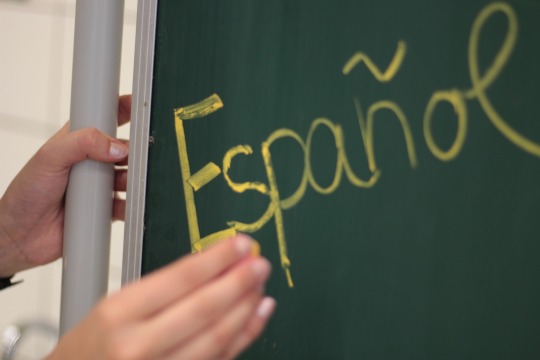
7. It won’t take you too long
Now, how long it takes you to learn Spanish is entirely dependent on who you are, how you study and if you’ve studied it, or a similar language before. According to the American Council of Teaching Foreign Language (ACTFL), languages are divided into two classes:
Group I: Spanish, French, Portuguese, among others
Group IV: Arabic, Chinese, Japanese and Korean
The languages in Group I, which include Spanish, take 480 hours of professional curriculum to achieve mid-advanced fluency. It’s important to remember here that how one defines “fluency” is entirely subjective. Some folks say they’re fluent in a language if they can read and write without a dictionary. Others claim that true fluency is impossible because it’d take a lifetime to understand all of the cultural idiosyncrasies if you didn’t grow up in it. Either way, Spanish is widely regarded as one of the easiest languages to learn, so you can be up and running with basic reading and speaking skills in no time.

8. Slang will become a way of life
With 437 million Spanish-speakers in the world, it’d be crazy to think they all speak Spanish in the same way. Some people, like in Spain, speak Spanish with a lisp. Others, like in Argentina, shorten words (e.g. tranquilo, for calm, to tranqui) down and some people speak a Spanish creole, like in the Dominican Republic, that’s difficult for native Spanish speakers from other countries to understand. According to Wikipedia, Hispanic American Spanish can be grouped into:
Mexican
Central American
Caribbean (Cuba, Venezuela, Puerto Rico, Dominican Republic, Panama, Caribbean Colombia and Caribbean Mexico)
Andean-Pacific (Colombia, Peru, Ecuador, West Bolivian, and Andean Venezuela).
Rioplatense (Argentina, Uruguay, East Bolivian and Paraguay)
Chilean (Chile, Cuyo)
Within European Spanish (Spain), there are also a handful of dialects:
Northern Peninsular (Asturias, Castilla y León, Cantabria, Basque country, Navarre, Aragón, Rioja, Provinces of Guadalajara and Cuenca)
Central-Southern Peninsular (Madrid, Toledo, La Mancha)
Southern Peninsular (Andalusia, Extremadura, and Murcia)
Canarian (Canary Islands)
Despite all of these dialects, most educated people will be able to understand one another regardless of which Spanish-speaking country they’re from. Standard usage of formal Spanish in Hollywood and many forms of literature helps to create a standard version that most people understand. But, on the flip side, all of this diversity can help anyone become a master in cross-cultural slang. Each dialect and Spanish-speaking region comes with their own sets of idioms and unique cultural differentiators, which makes learning Spanish fun and engaging. The number of ways you’ll be able to express yourself will be endless.
9. More chances to fall in love
One of the benefits of learning Spanish or any language is that you’ll widen your pool of romantic prospects. We live in a world where the number of Spanish-speaking people is only growing. Those who don’t attempt to learn even a little put themselves at a romantic disadvantage. How amazing would it be to travel to another country and connect with others in their own languages, versus hoping they speak your own? Learning a new language naturally enriches your life, and gives you the opportunity to meet people whom you’d never be able to communicate with before. It is a gift, and something you shouldn’t deprive yourself of.
Want To Start Learning Spanish Now From The Best Possible Source Online Click Here
#spanish#learn spanish#learnspanish#spanish speakers#benefits of spanish#spanish learning#language#language learning#new language#newlanguage#spanish class#spanish classes
1 note
·
View note
Photo

Artist @ceciliavicuna and our director of photography #MatíasIllanes checking the camera under a natural wall of #ñirre forest in #TierradelFuego. Also known as #NothofagusAntarctica, ñirres are a native species of the Patagonia Andean #forest. Don't miss the premiere of DISTANCIA in Melbourne! Monday 25th March From 19:00 - 23:00 - Long Play bar and cinema 318 St Georges Road North Fitzroy 3068 LongPlay cinema seats 30 people and the first season of DISTANCIA goes for 35 minutes, so all seven episodes will be screened numerous times during the night, at 7.15, 8.15, 9.15 and 10.15, come when you can or watch it twice in a row! After each screening there will be a short Q&A with one of the directors, Camila Marambio. (at Tierra del Fuego) https://www.instagram.com/p/BvNHjsPDoz2/?utm_source=ig_tumblr_share&igshid=1u3kj5wdz36ik
0 notes
Text
Chile - a land I fell in love with
CHILE - a country I thought I was going to spent 1 week but ended up staying almost a month. Land of deserts, of cities, of volcanoes and of Patagonia. Land of beauty, of Nobel prize winners, of culture and much more.
SAN PEDRO DE ATACAMA
Day 1. (23.10). After border control it was a 45 minute drive to San Pedro de Atacama. The views were stunning. Chile is an hour ahead of Bolivia so we arrived at 12ish noon. I headed to Laskar hostal. After check in we headed into town to get money and exchange money. The town only has a few ATMs and all charge so take out a bit of money at once instead of a bit at a time. Then we rented bikes from Rutas Atacama that is on Caracoles street inside Licher - its like a stand. They do 3,000 pesos for 6 hours and double for 12hours. We then headed at 3pm to the Vale de la Luna. It's stunning but I would not recommend cycling as it's all uphill and it's quite a bit of a way. Either give yourself a lot of time and take a lot of good and water or take a tour. The entry is 3,000 pesos. At night I decided to cook and by the hostel there is a cheap supermarket and Vicents supermarket on Licancabur street is also a cheap option. For fruit and veg the agro market is a good option.
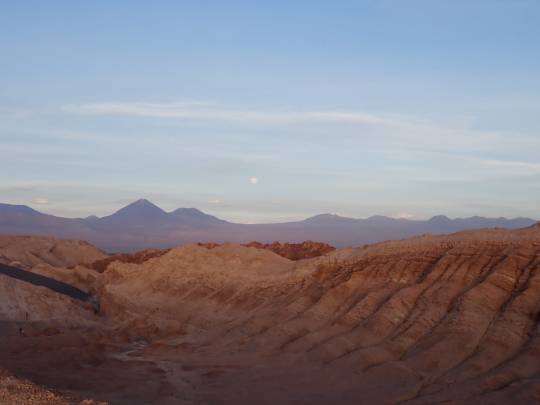
Vale de la Luna, San Pedro de Atacama
Day 2. (24.10). Wake up at 8am and went to get bikes at 10am. I headed towards Pukara del Quitor but first I headed further into the Catarpe National Park on the other side of the river. Inside the park I cycled to Los Túneles, the Quebrada del Diablo and a white church at the end. Do the Túneles first then the Quebrada then the church. I got there for just before 10:30 and left around 1pm. It will take you around 3 hours to do the whole park comfortably. It costs 3,000 pesos to get in. Then Pukara de Quitor; the ruins of a fortress over 2,000 years old from the atacama civilisation. Here you will find the ruins, various miradores (1.7km walking to the furthest out) and a face sculpted into the rocks. It is also an awesome place. I had lunch around 2pm at the top of the mirador and was done for around 2:30pm and back in town for just after 3pm. The whole day took me just over 5 hours. Again make sure you take plenty of water and potentially consider doing the two places on separate days for a more chilled day.
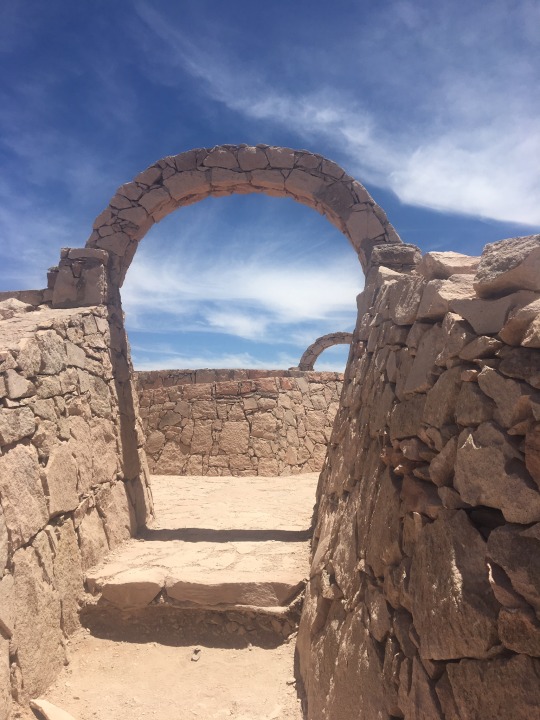
At the last mirador of Pukara de Quitor
Day 3. (25.10). Today I booked a tour through Desert Adventures - based on one of the corners of Caracoles street in San Pedro. First stop is the Chaxa lake (2,500 pesos). Here you can find the salar of Atacama which unlike the Uyuni salar it was made during glacial times by the minerals dragged off the volcanoes. It hosts three flamingo types- the Chilean flamingo (pink and dances to displace ground for food in a step step motion), the Andean flamingo (black tail) and the James flamingo (yellower beaks). Then to the red stones (iron minerals) and it's lagoons and lastly a little town called Socaire and Toconao.
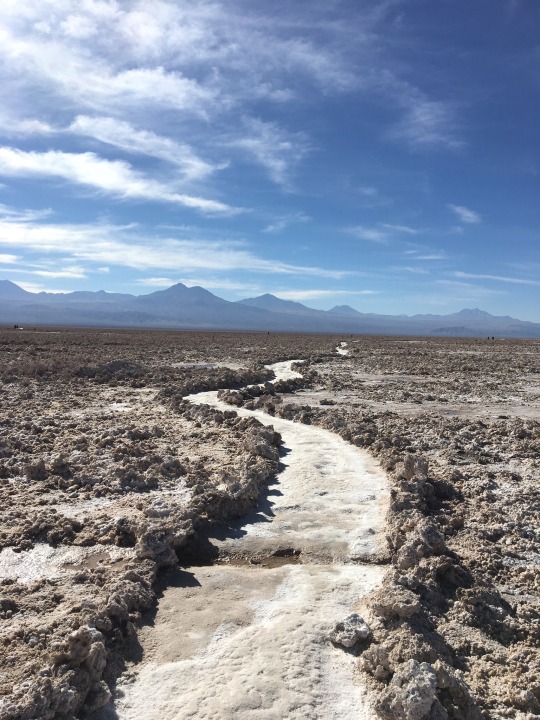
San Pedro Salt Flats
Day 4. (26.10). On my last full day at San Pedro de Atacama I went off to the Puritama springs (Los Termales de Puritana). The trip started at 8am and I was back at 13:00. Super amazing and relaxing!
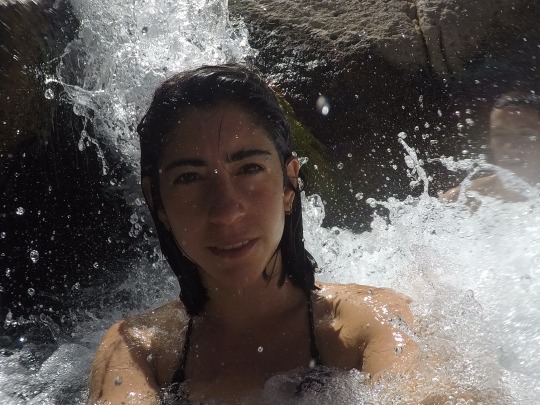
Puritana Spring
——————————
CRIBSHEET OF SAN PEDRO:
Hostal: there are many hostels in San Pedro. I stayed at Laskar.
What to do:
Vale de la luna - by bike: 1 day; with a tour: half day. If you do this by yourself take at least 2lt of water per person, a head torch (which you can get when you rent a bike); a bike; sunscream.
Pukara de Quitor Ruinas - I would recommend you do this with a bike as its so close to town. Make sure you take cash with you, water and sunscreen. You will have to leave bike behind and walk around the archeological site but that’s super doable in 1-2 hours.
Valle de cantarpe. If you decide to do this do it before Pukara as its further out and more tiring. Make sure you set out a good 4 hours and bring plenty of water, food, sunscream.
Tour de las estrellas. Book a tour to do this. I did not manage to do this as during my time there it was full moon so make sure you check the moon as a full moon won’t allow you to see the stars.
Alicancabur. This is the name of the volcanoes that borders Chile and Bolivia. You can do tour to the laguna verde y carácter.
Hot springs - Terma de Puritana tour. Either rent a car and go or go with a tour. I did it with a tour and its either in the afternoon or morning. So half a day.
Tebichinki
Laguna artiplanas y piedras rojas. This is a full day’s tour where you stop at the San Pedro salt flats and another two lagoons
Salt Flats. You can also to do the salt flats from San Pedro either dropping you off at Uyuni or coming back to San Pedro.
Rental bikes: Rutas Atacama
Tour company: Desert adventure ——————————
SANTIAGO
Day 5. (27.10) Today was a chilled day. Waking up breakfast and going round town for a bit before lunch and heading to Calama airport. I flew with Sky airlines. Landed and headed to the exit. You can get taxis or you can get colectivos for a bit less that leave you outside your hotel/hostel. These are outside the duty free before you exit the baggage area. Super easy and range between 6,000 and 8,000 pesos compared to an Uber at 14,000 and taxis a bit more. I got one named Delfor that dropped me off in front of the hostel. I stayed at Providencia hostel in Santiago.
Day 6. (28.10). On Sundays many streets are closed for the cyclists and runners. So its quite pleasant to walk around. I headed in the morning to the Santiago teleférico and went all the way up had this Santiago drink with durazno and maiz and lunch at belas artes followed by some yummy ice cream called Rosa nearer to the hotel.
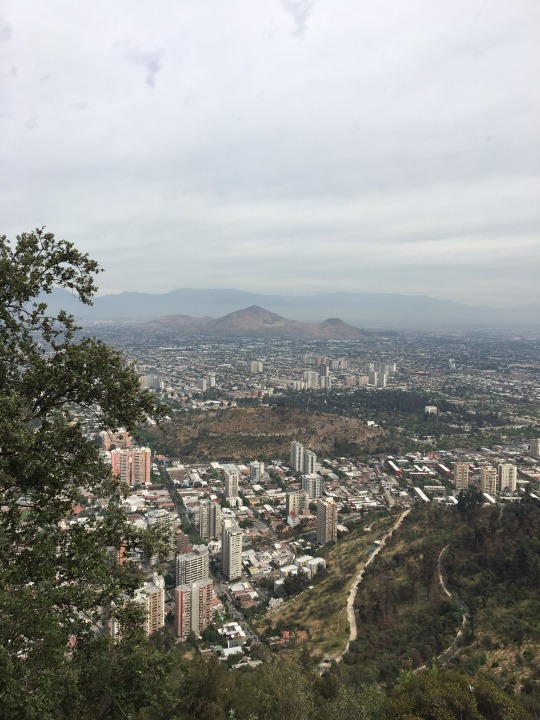
View from the top of Cerro San Cristobal
Day 7. (29/10). I used this day for planning. You could look into heading to the Maipo maintains. I ended up not doing it. At the Providencia hostal you can find someone selling these tour.
Day 8. (30/10). I headed very early to Valparaiso. I would recommend waking up at 6am and being out by 7 ish. I left around 7:30/7:45 and made the 8:20am bus with Turbus to valparaiso. I bought the ticket at the station. Buses leave from station Pajaritos (line1/redline). Price varies but I paid 5,600 chilean return. The way back is an open return so you can show up and get any return and they leave every 15 mins. When you get to Pajaritos metro just get out of the metro and the booths to buy the bus tickets to Valparaiso are right there. Just ask around for the cheapest. They have two main bus companies: Pullman and Turbus. The trip to Valparaiso is around 1.2 hours. I got there around 9:40am and just made it for the 10am walking tour that leaves from Plaza Sotomayor. The guides of the walking tour are dressed in “where’s wally” like tops (red and white stripes) so its fairly easy to locate them. From the terminal de buses to the centre is a good 30 min walk. You can privately get a bus or taxi in. The am walking tour takes you up to the old prison and cemetery so it's an alternative route and I quite liked it. I then did the old town int he afternoon by myself but you can also get the same walking tour in the afternoon.

Streets of Valparaiso (Calle Uriola)
The afternoon tour goes to the German church luterana, and several viewpoints. I did it my myself starting at calle Uriola where you will find a bar and cafe called Al Alba that is super sweet. Walking up you get awesome street art. At plaza Sotomayor there is also a good café called 504. And for food near the port there is Buenos Aires restaurant that does good menu del dia. Other restaurants are Lupita, Pizzeria Ecuador - all at calle Ecuador. Be aware that Calle Ecuador is no longer the historical centre but according to my guide the area is still known as the bohemian side of town but its not too safe so be careful.
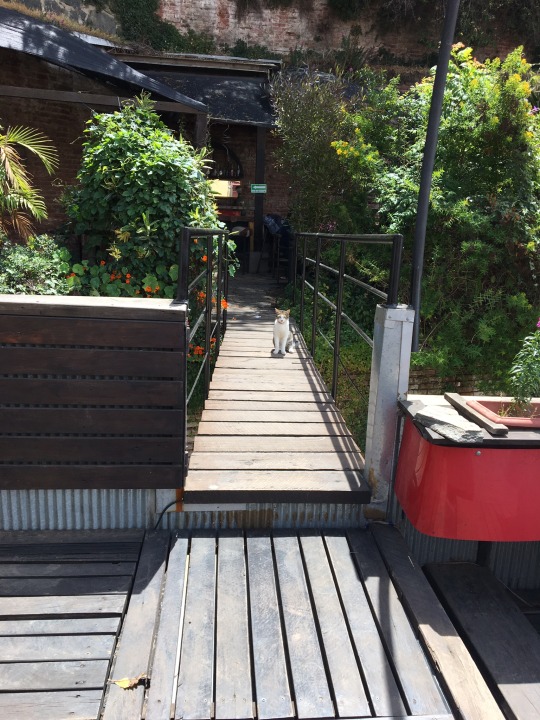
Rooftop space at Cafe Al Alba (Calle Uriola)
Day 9. (31/01). I quickly headed to the Universidad de Santiago station (red line) to buy tickets to Pucon with Turbus. I then headed back to the city centre - first to the Moeda station and the museum of lá moeda which is free until 12 noon. Then walk to the Precolombiano Art Museum and Plaza Mayor, up to el mercado and back down. Then I headed back to the hostel through Lastaria area and stopped at the park with the fortress at the top. I read a book there for 4 hours and then back for dinner and Halloween night out.
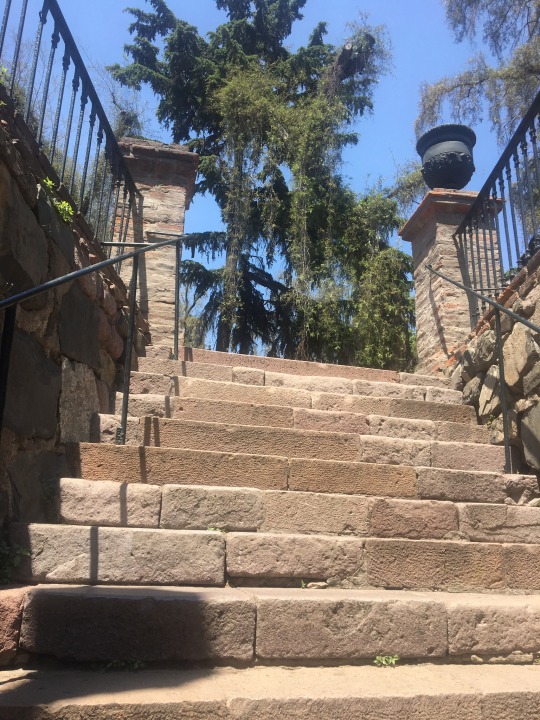
Day 10. (1/11) day of rest, home comfort and cinema. A family friend took me for coffee lunch and the cinema as well as dinner. Blessed to have been taken care of like that and enjoyed a nice family rest. You can also chose to go to the many wineries around Santiago on this day. You just get the underground a couple of stops and you can arrive in one of the many wine houses one of which being Concha y Torro.
Day 11. (2/11). After breakfast and a rest we headed for an early coffee at Lastaria. I then headed out on the red line to the Santiago Artesan Market further out round the corner. It was a pretty market and we had some food there. I was back at the hostel for my last night in Santiago.
Day 12. (3/11). I woke up and did the check out before heading to breakfast. We headed into the city and walked to Lastaria to get a coffee and then decided to walk to the Human rights museum. The walk was far - about one hour but there was always the green like tube straight back near the hostel. Later we did a trail up Cerro San Cristobal to watch the sunset. It took us over an hour to climb as we took the road instead of gravel route by mistake. We took the gravel route on the way back. We were at the bus station for 10pm as our bus was 11pm. Ways to Pucon: flight or bus. The flight is to Temuco or Calama and bus from Univesidad Santiago (10hrs).
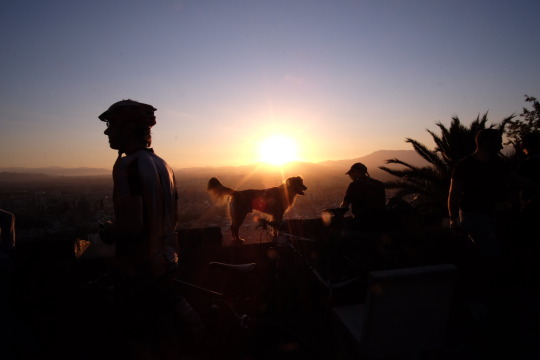
Sunset at Cierro San Cristobal
——————————
SANTIAGO CRIBSHEET
Hostel: Providencia Hostel
Things to do:
Lastaria area
Walking tour either by yourself or with one of those free walking tours (get info at the hostal)
National Museum
Precolombian Art Museum
Cerro de San Cristobal
Maipo treking
Wine tour at Concha y Toro
Mercado central
Valparaiso and Vina del Mar (get there with Turbus or Pullam from Universidad Santiago station)
Bellavista (especially during the night cool bars)
Restaurants:
Mercado central
Chipe Libre
——————————
PUCON & PUERTO VARAS/MONTT
Day 12. (4/11) after arriving in Pucon and finding the hostel we had a nice chilled morning. The hostel (Chilli Kiwi) by the Poza was easy to get to. From the bus terminal (right out and on the main road right) or the city centre just follow O’Higgins road all the way down until you hit the lake (they call this part of the lake the Poza; in Spanish it means the puddle). Then when you hit the lake turn right and the hostel is right there. It has a beautiful view of the lake. Unfortunately, in November, the time we were there, it meant that the sunset was behind the buildings on the left and not straight across from the hostel. Apparently a couple of weeks back (so more October time) it was more central. The weather was very rainy so bought food and chilled at the hostel kitchens. Staying at Chilli Kiwi was an awesome choice as its by the lake. The rooms are clean and good and your rent can range from 9, 6 or 4 bed dorms. They also have a 2 bed dorm for walk ins as well as a 3 bed Harry Potter room, the caravans (20-22,000chl) and the tree house (32,000chl).
Day 13. (5/11). Woke up and headed out around 10:30am to Salte del Claro. Make sure you ask the route at Chilli Kiwi as they have a pretty comprehensive map. Here you walk towards a waterfall. Its beautiful and it will take you around 4 hours round trip. We got to the waterfall just after 12. Its stunning and even better due to the strong rains the day before. The path is fairly well signposted but if in doubt bear right when going through the forest at the end and have the river to your right. On the way back we got a ride back which sped up the trip.

Salte del Claro
Day 14. (6/11). Chilled in the am at the hostel and kayaked the lake from 1-3pm. It's 5,000chl per person and 4 hrs on the lake max time. Then back for my last night. During the am day bought tickets at JAC terminal, just off O’Higgins road, to Puerto Varas. As a rule, stay at Puerto Varas (at Maguoy Patagonia) and not Puerto Montt. Buses leave frequently from Puerto Varas to Puerto Montt.
Day 15. (7/11). Bus at 9am (9,500 chl) to Puerto Varas. I found out that Juan was also heading the same way as me so I glued onto him. Funnily enough we were to trek the next day together and meet again in Buenos Aires for some typical Colombian food - and who said you can’t be international in every sense of the word?!?! The trip took 4/5hrs. I then headed to the hostel (Margouya Patagonia (see leaflet below)). Then I went for a wonder round the town and bought food.
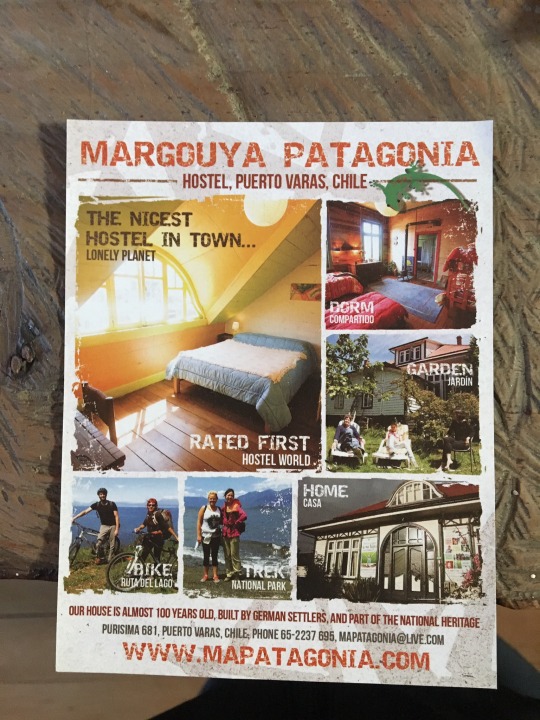
Day 16. (8/11). Wake up early and headed to Petrohue Park. The bus left from town (if you are at Margouya turn right out of the hostel, then right again at the main road as if you are headed into town and then left at the bottom of the hill by the fish restaurant; its just down there) and final stop was the park. The bus fare cost us 2,500chl each way and took 1.5 hrs. The trek was 4 hours all the way round. The full round trip is quite exhausting as quite a bit of it was volcanic sand which is not a joke to walk on. We were back for 5ish. Early night as I had bought a boat fare down the Fjords to Puerto Natalie’s (southbound only leaves on Fridays and Northbound only leaves on Mondays).
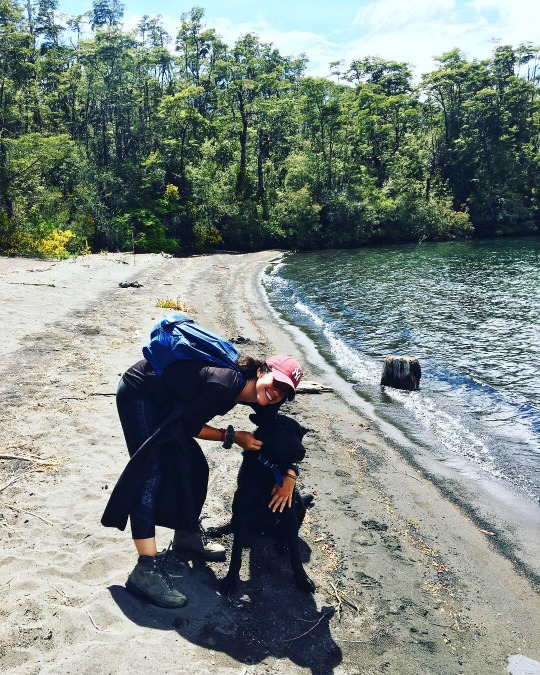
Petrohue park (me and our not so trustworthy but loyal guide - Rix!)
———————
PUCON & PUERTO VARAS / MONTT CRIBSHEET
Hostels:
Pucon: Chilli Kiwi
Puerto Varas: Maguoy Patagonia
**If you are by any chance going to: Valdivia, stay at Kauai central lodge; or Cochamo, stay at La Bicicleta Hostel; or Ancud stay at 13 Lunas Hostel; or Castro stay at La Minga Hostel or Palafito Waiwen (Chiloe).**
Things to do:
Pucon: climb the volcanoe; canoe on the lake; Salte del Claro other national marks/waterfalls. Make sure you ask at the reception at Chilli Kiwi and be around for the intro talk they do daily.
Puerto Varas: Petrohue Park; waterfalls. Just ask at the reception at Maguoy Patagonia.
Restaurants: to be fair I cooked a fair bit in Chile so just ask at the hostel the closes supermarkets which in all had one a max 10 min walk and enjoy the very cheap and good selection of wines.
———————
PATAGONIA
**Just a quick note here. You have a few options to travel down to Patagonia. You can either fly from Santiago or another airport near Pucon to Punta Arenas and then get a bus up from Punta Arenas to Puerto Natales; or you can rent a car around Puerto Varas/Montt (there are a few caravan companies around or if you rather bike it there are a few options too); or you can do what I did and get on a boat (called NAVIMAG at Puerto Montt which will drop you off four days later at Puerto Natales). Of course, if you want to stop more often you also have a few other options like getting a boat with TABSA that takes you from Puerto Natales to Caleta Tortel and other destinations. Equally if you are travelling northbound these options are still the same. However, please note that NAVIMAG boats only leave from Puerto Montt to Puerto Natales on Fridays and from Puerto Natales to Puerto Montt on Mondays.**
Day 17. (9/11). Woke up at 7 and got everything ready. Headed out around 9 ish and got the bus at the end of the road (Calle Imperial). The fare is chl900 and it takes 20 mins to get to Puerto Montt. So I got in for 10am . From the station I got another bus (just ask around for the Costanera Shopping Centre/Holiday Inn) or you can walk (its probably 20/30 mins) where the check in was which is just down the road meaning I got in for 10:30 ish (this second bus cost me chl400). It's also where the Costanera Shopping Centre was. The boat left at 3:30pm so I could have arrived a bit later. But still. We were on the boat for 4pm and only left the port around 8pm. The whole trip cost me USD350 for four days/three nights all inclusive.

Sunset leaving Puerto Montt
Day 18. (10/11). I wake up on this boat and am surprised how well I slept. It's an interesting life on the boat but the bed, the showers and the amenities are very good. There are about 100 passengers and it feels full but not too crazy. Breakfast at 8am. Very well served the meals. The views are stunning. During the day there were talks of the route we were to take, a yoga class and materials around to colour in, knitt etc. The day went fast. There were talks about the route we were taking. The day ended going into the golf with a stunning sunset. The stars were even better.

Sunset on Day 2
Day 19. (11/11). Second full day on the boat. At dawn we had just crossed the golf and were back in the Fjords. The golf was quite calm and I only felt the boat rock twice. We stopped around 3pm at the Eden village with 3,000 people where only four people of pure blood of previous native people of this area. There was a talk about Torres del Paine - three entrances, bus in and a few options for day treks. We went through quite a few narrow straits. We went through the Cotopaxi shallow where the Leonides ship sunk (legend says there is another ship below it as it lies quite high above the water). We went through 89 wide straights with meter tall granite rocks. The day ended quite cold and the night was overcast so no stars.
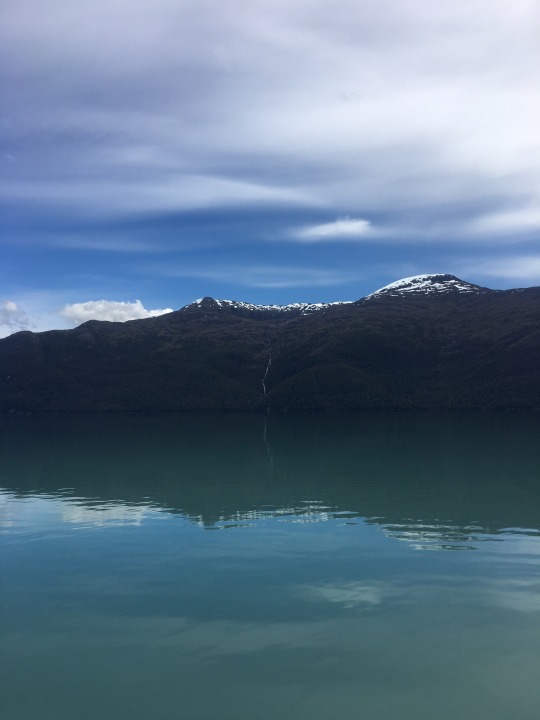
Clear day through the Fjords
Day 20. (12/11). Last day on the boat. We woke up to an overcast day. We had breakfast and I did a bit of exercise and headed to the bar to write. The day eventually cleared. We docked at 4pm and it took close to two hours to get out. I then headed to my hostal: We Are Patagonia. The hostal was really good! Super comfy beds although a bit more expensive than the usual. Included breakfast which was very good. I arranged as well a rental car and shared it with two other people. Ask at the desk at the hostal for more information as they have the numbers for the cars. It also depends if you want to do day trips to Torres del Paine or whether you will be doing one of the treks (3-day or 8-day).
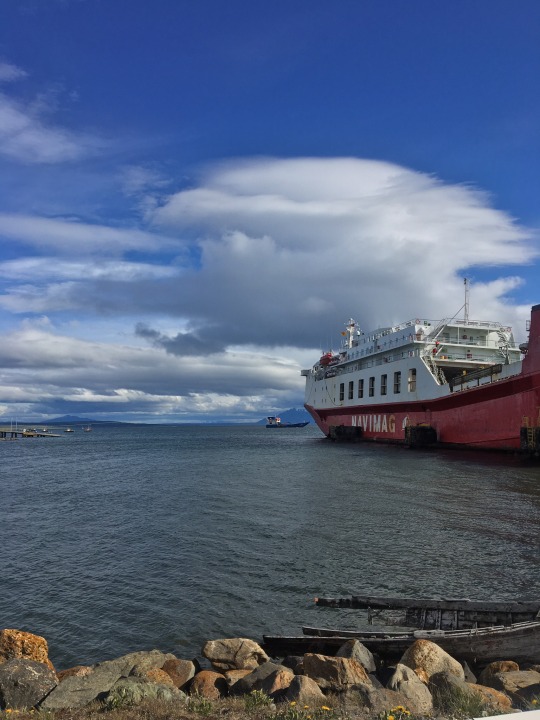
Leaving the boat (Navimag) at Puerto Natales
Day 21. (13/11). We woke up at 5am and headed out at 5:30am to Torres del Paine. The park is quite big and you can do the O in 8 days, the W trek in 3-5 and all of these need planning and booking if you want to stay overnight at the park. Although I was with some people who just winged it and did the towers one day, then the second drove to the middle to do the Britannia climb. The campsites have more flexibility as they may have last minute spots and you can rent tents at Puerto Natale’s from 2,000 to 5,000 for a 4 person and 3,000 for sleeping bags.
Getting to Torres del Paine National Park
What we did was rent a car and go very early to the Serrano entrance (there are three entrances). The Serrano is the most scenic route (the buses don’t use this route) with lakes. This road is not tarmacked but quite good. The entry to the park is 21,000chl and you can come in and out of the park up to three days. The parking is free. The day walks you can do are Torres (entrance on the east); the French valley and grey glacier (both entrances closer to Serrano). The last two start in the same spot so the guys I went to did grey and I did the French valley. For these two the Serrano entrance is the closest. You then park by Pahoe lake and get the ferry for 9am. Which gets in for 9:30am on the other side of the lake.
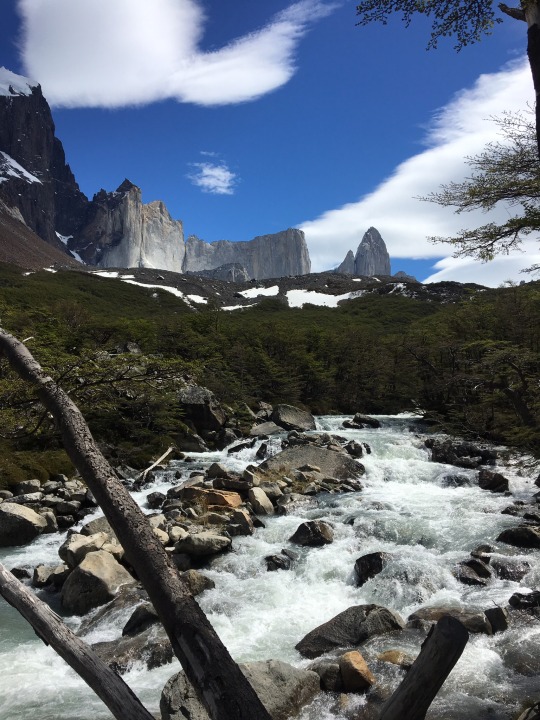
River running next to the treck to Vale Frances and Britannico
The trek
As the boat got in at 9:30am on the other side I started treking at around 9:40am. The map says that the first section of the trail up to the bridge is 2.5hrs but in brisk pace I made it in 1.5hrs. The views were stunning. Crossing the bridge you are by the French and Italian camps. Here is where the W joins. Across this very wobbly bridge to the other side I went. From there through the forest I got to the French mirador within one hour. From the mirador Frances to the británico I took about an hour as well but that's because a lady told me that the top closed at 13:00. But when I got there there was no gate. Asking around I heard that CONAF could have a guide shutting the trail if weather was bad maybe. The views at the top were absolutely stunning. Breathtakingly beautiful and no picture does it justice. So I got up there for 13:00, lunch for one hour and headed down at 14:00 to get back before 6pm for the 18:35 boat. We got to PN at 10pm. It’s a long day so take plenty of water and food. Make sure you take clothes for hot and cold/windy weathers and be ready to sweat.

The view at the top
Day 22. (14/11). Today I decided not to head out and do Torres del Paine as the Vale Frances was quite heavy and a full day. That's why I would recommend staying four day or three full days min in Puerto Natales so you can do Vale Frances one day and then do Torres on the third having a rest day in between. I then headed out for some food and chocolate. I was also recommended Patagonia Dulce (apparently best hot choc in PN) and La Gregario for coffee and chill. Also Pampa and Baguales as good bars. The afternoon went super fast catching up with people and resting. In the evening we sat round a table and chatted for hours. It was the best way of closing my Chile chapter. Thanks Chile!

Just an awesome group of people I met (two faces missing)
Day 23. (15/11). I was getting the bus to el Calafate at 7:45am. The bus ticket came to 20,000chl and the terminal was not crazy far. I travelled with Bus Sur and they were good.
————————
USEFUL INFORMATION:
Money: Chilean pesos
Hostels:
San Pedro de Atacama: Laskar Hostel
Santiago: Providencia Hostal
Pucon: Chilli Kiwi
Puerto Varas: Maguoy Patagonia
Puerto Natales: We Are Patagonia
Torres del Paine: book your stays with Fantastico tours or Vertice.
Info on Torres del Paine trekking options: -1 day - advise renting a car which goes at 40-45,000chl per day instead of getting the bus as with the car you can then get early for the first boat. You can then do Valle Frances one day have a rest the second day and on the third do Torres. I tried to do one after the other and it did not work.
- the W : 3-4 days. You must plan this in advance and book the campsites. In this case you will get in on your first day and do Torres or stay overnight at base and wake up early to see the sunrise and on that same day walk to the second campsite between Torres and the French/Britanico. On the second full day you will do French and Britannico to get to the third campsite by the boat. Your third full day you will do grey and come back on the 6pm boat, then bus back to Puerto Natales.
- the O: 8 days: Day 1 Get there in central camp at 11am and get there at 3pm. Stay at camp seron. Day 2. Set off at 9 am to camp Dickson. Day 3. Take easy morning. Short day and stay at perros. Day 4. From perros to grey. Start at 6am. Don't do Paso as with Conaf and need not book with three. Day 5. Walk down to grande or Frances and camp - Frances. Day 6 from Frances walk The Valley and come back pick up stuff and stay in cuernos. Day 7 walked to chileno or central - chileno no cooking. Day 8 do Torres for sunrise and go back get your bag and head down for the bus. Book in June for November and book meals throughout and for later stops so as not to carry too much food.
————————
#chile#sanpedro#desert#santiago#pucon#puertovaras#puertomontt#puertonatales#patagonia#torresdelpaine#thingstosee#thingstodo#journey#travel#visionworld#vision#yourworld#myworld#ourworld
0 notes
Text
For All The Chaos In Venezuela, Its Cinema Is Thriving (For Now)
"La Soledad is the latest in a glut of Venezuelan films telling unflinching, complex stories of life in the troubled Andean nation. It might seem surprising, given the increasingly authoritarian regime of Nicolás Maduro, that these films have often benefitted from state funding. ... A major reconfiguration came in 2005 with a reform to the country's national cinematography law. This dictated quotas for the proportion of Venezuelan films in theatres, initiated a tax on cinemas and distributors to fund Venezuelan film-makers and granted tax exemptions for private-sector support of Venezuelan films. Since the new law came into effect, more and more Venezuelans have been going to cinemas: a record 4.2m did so in 2014."
Article source here:Arts Journal
0 notes